

Posts Filtered by Tag - Appalachian Trail |
Show Recent Posts
April 1, 2021
New Year's Eve at the Allentown Shelter: An AHC Tradition
by Barbara Wiemann
New Year's Eve at the Allentown Shelter: An AHC Tradition
by Barbara Wiemann
Al and I were married in 1976 and we wanted to do something different on New Year's Eve to end that Bicentennial Year. Since we met on an Allentown Hiking Club Appalachian Trail hike, we decided to backpack to the Allentown Shelter.
It was a bitterly cold night. We slept with our boots and water bottles in our sleeping bags. Al is an amateur radio operator, he carried a 2 meter handheld radio and, using a repeater, was able to make a phone patch to place a phone call to Harold Croxton, AHC's Trails Chair. In the morning, we discovered that it was so cold and windy that the Philadelphia Mummers Parade had been canceled.
We had so much fun that in 1977 we placed the backpack on the club schedule. Two hearty members joined us. As the years went by, more and more people ventured out with us, providing entertainment and conversation far into the night. One year a teenager brought his guitar, serenaded us, and led a sing-along. We had human joke machines to keep us in stitches, and storytellers to regale us. And we could always count on fireworks down in the valley at midnight.
Naturally a highlight of our evenings was food and a fire. Each year, different participants brought new choices. We fried steak sandwiches, roasted potatoes, cooked hot dogs, and even feasted on the traditional Pennsylvania German pork and sauerkraut, we drank cocoa and toasted in the New Year with sparkling juice served in plastic flutes.
In 1994, when she was 12, our daughter Liz joined us. Three years later, with a nice snow on the ground, she was the first person to reach the new club shelter and snapped a photo that was selected for the Appalachian Trail Conservancy calendar. And in 2016, our 5 month old grandson Curtis made it a three generation event when Liz carried him to the shelter.
After 30 years of backpacking, in 2006 we switched to a day hike format. As a result, the group size increased dramatically. Some years, 30 to 40 people have trekked to the shelter. This, of course, has provided for plenty of socializing and even more noshing choices on the picnic table. On occasions when I have not been able to lead the trip, other club members (MaryAnn Wagner, Karen Gradel, and Paula Uhrin) have stepped up as leaders.
Over the last 45 years, through snow, icy snow, rain, freezing rain, wind, and, occasionally, balmy (temperature above freezing) weather, the Allentown Hiking Club has celebrated the New Year at the Allentown Shelter. Plan to join us in 2021 as AHC marks its 90th anniversary!

April 1, 2021
50,000+ Miles... On Foot!
50,000+ Miles... On Foot!
Since 1985, Ginny Musser has kept track of her miles walked on trails and around town.
Virginia (Ginny) Musser, a longtime member of the Allentown Hiking Club, has been keeping track of miles hiked/walked since 1985. Her first hike with AHC was in 1978 with the venerable Earl Raub on an A.T. hike thru St. Anthony's Wilderness. Earl was known to schedule hikes on the A.T. in Pennsylvania so that if you did all his hikes you'd complete the A.T. in the Commonwealth. Although this hike was in Earl's series Ginny did not get in on the beginning of the series. But as a result of getting hooked on hiking she picked up the missing sections and completed the PA section with the rest of the club on July 13, 1980.
Ginny credits Earl with teaching her everything she needed to know about hiking and safety on the trail! Although Earl passed away in 2005 she still maintains contact with his wife, Anna.
It wasn't until 1985 that Ginny began recording the miles hiked/walked on a calendar, totaled at the end of the month and then a final tally at the end of the year. At the end of 2019 she realized that if she kept her pace she'd hit 50,000 miles by the end of 2020. Actually she passed the 50,000 mile mark back in the spring but didn't realize it because she doesn't total for the year until the end of December.
Included in those 50,000 miles are the A.T. from Georgia to Maine completed over an 11 year period as well as the 18 state hiking trails in Pennsylvania, the Allegheny Trail that runs the length of West Virginia, as well as the miles accumulated doing trail work around the State as well as on her AHC assigned section of A.T.
She also tracked the number of miles on various pairs of hiking boots!
Included in those 50,000 miles are her daily jaunts around town and on local rail trails.

September 29, 2019
Fall Is Here
by Karen Gradel
Fall Is Here
by Karen Gradel
Fall priorities include reporting your AT volunteer hours, learning about charcoal hearths on Blue Mountain, and attending our end of year events.
Summer is over and our trail maintainers have spent many hours clearing blowdowns, blazing, getting rid of invasive plants to keep the path clear. For all those who have helped with the maintenance thank you and don’t forget to get your volunteer hours into Ed Ritter by Oct 9th. Also anyone else who has helped with corridor monitoring , leadership, administration, websites, newsletters, finance, etc. should submit hours too. Things not to report are participating in (as opposed to leading) recreational A.T. hikes, planning or attending social events, such as dinners and picnics, feeding hikers, a.k.a. ‘Trail magic’ or trail maintenance on trails other than the AT. Why is it important to report all of our hours? ATC uses the hours of all the volunteers to obtain NPS funding.
It is also the time of year we do Corridor Monitoring. If you are interested in helping with the monitoring or just want to go along and find out what is involved, keep your eye on the forum or contact Lucy Cantwell.
A ‘don’t miss’ is the October presentation by Muhlenberg college Professor Benjamin Carter who will give a talk on his research of the charcoal hearths located on the Blue Mountain. There will also be a hike on October 5th to accompany his presentation and give us a ‘first hand’ look at the charcoal pits. Coming up we also have our holiday pot luck on December 4th, our holiday hikes and our annual New Year’s Eve hike to the Allentown Shelter that has been a tradition since 1976.

September 29, 2019
Trail Magic Events
Trail Magic Events
Photos from our annual effort to ease the burden of thru hikers as they make their way to Maine and Georgia.
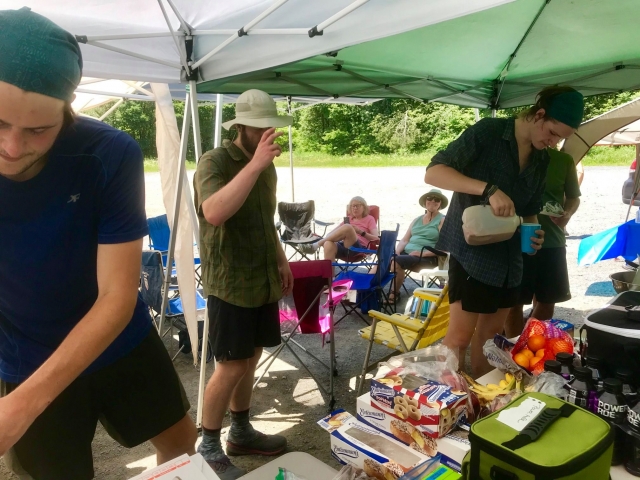
The chocolate milk was a hit.
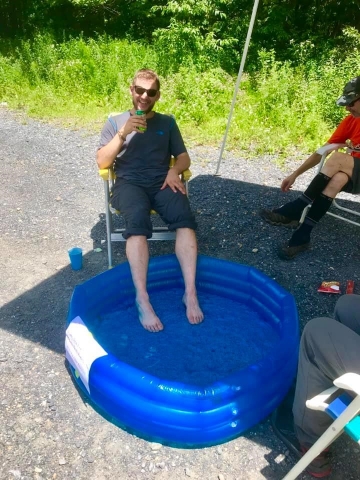
A pool to cool tired feet.
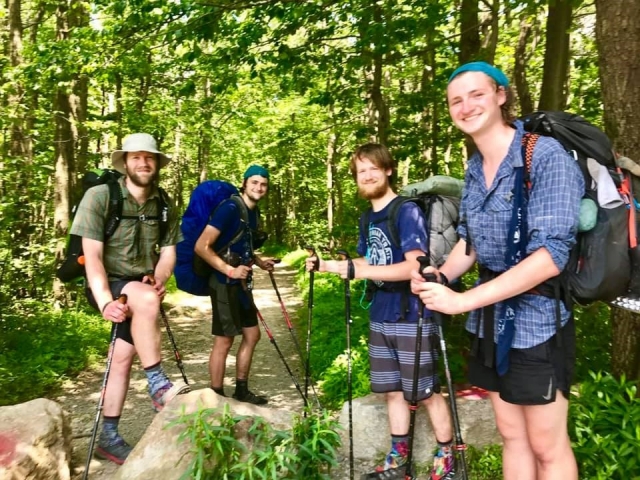
Four happy hikers head back to the trail.
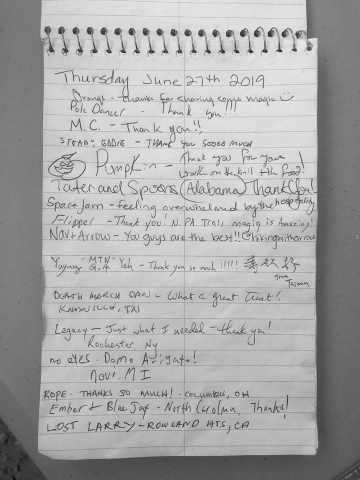
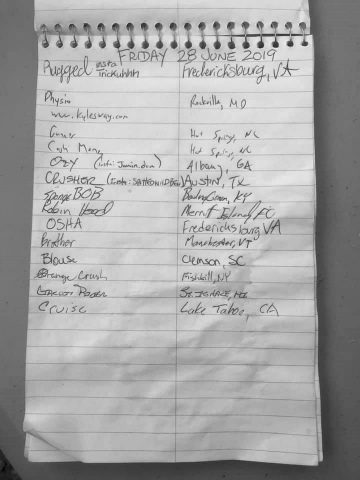
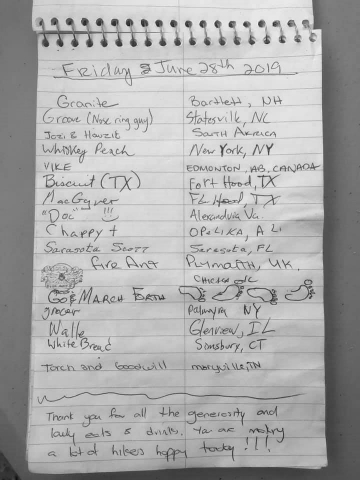

September 29, 2019
Second Section Hike on the Appalachian Trail
by Terri Stubits
Second Section Hike on the Appalachian Trail
by Terri Stubits
Our Massachusetts summer section hike.
Last year, we (Neil and I, Tom, Patti, and their son Trip) did our first section hike on the Appalachian Trial in Virginia and decided to do another section hike this year. Tom and Trip have completed the AT in VA, WV, MD, PA, NJ, NY, and CT. They have completed about half of MA, and this is where we decided to section hike. Patti plans all the logistics, and I made reservations at the Berkshire Lakeside Lodge in Becket, MA for our first night after driving up. This lodge is 0.1 distance from the trail. The lodge also let us leave our vehicle there while we hiked. Our plan was to hike (Tues – Fri) from the lodge to Cheshire, MA, a distance of 28.3 miles. Shuttle back from Cheshire.
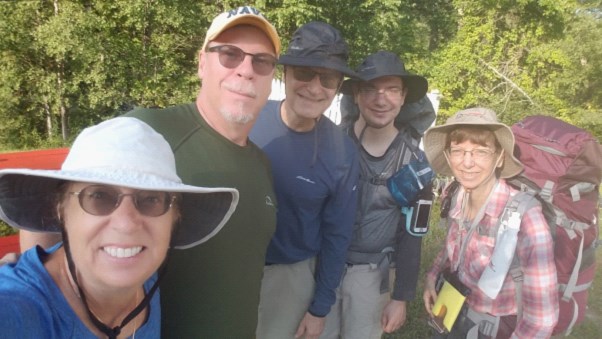
Left to Right – Terri, Neil, Tom, Trip and Patti
Tuesday morning we started out with a 780 foot climb up Becket Mountain, and continued to the October Mountain Shelter (7.2 miles). Because there was not a reliable water source near the shelter, we stopped 2 miles prior and filtered water and carried extra water to the shelter. The water looked like weak tea even after going through the filter, so I added tablets just in case. This tea tinted water tasted great! Really, it was delicious. Carrying the extra water weight for 2 miles was killer and Neil carried most of it for me. We arrived about 3 pm, and picked out a campsite. It immediately started pouring rain as soon as we got our tents up! Pounding rain for about 1 ½ hours, with water pooling around our tents. As the rain was stopping, we heard a loud thunk! A thick dead branch came down right between our tents. We made dinner (had mini bottles of wine a neighbor had given me, which Tom carried), wiped some of the mud off our tents, and got our bear bags ready for storing. This shelter has a bear box which is really nice. Downside was the mosquitos. Patti and I got bit the most, even after using bug repellent.
It didn’t rain any more that night so our tents had a chance to dry out. Wednesday morning, while eating breakfast, we checked the weather for the Kay Wood Shelter (8.8 miles) and the forecast was for severe thunderstorms and heavy rain that day and into the night. We made a quick decision to hike 12 miles into Dalton, MA. Called for availability at the Econo Lodge in Dalton and made reservations. Now we just hoped we’d get to town before getting caught in the downpour. All day there was thunder but no rain. We stopped for lunch as well as several quick breaks. Tom brought Pellegrino which is very refreshing on the trail. Trip was out front setting a good pace, but I was struggling with all the ups and downs on the trail. Tom turned on his Bluetooth and started playing music. First song was “99 Luftballons” and it really helped me to keep going. I drank most of my 2 ½ liters of water and we stopped before getting to town to filter more water.
We walked to Angelina’s Submarine Shop with cheesesteak bombs on our minds. It was about 5 pm and again just as we got there it started to rain. We left our packs out front under the picnic table umbrellas and went inside to order. These cheesesteaks are loaded with meat, nice and hot, so good. I took out my phone and ordered an Uber to take Neil and I back to Becket to pick up our truck. By the time the Uber delivered us to the Berkshire Lakeside Lodge, the rain had turned torrential with white bright lightening and booming thunder. Neil and I drove back to Angelina’s to pick up Tom, Patti and Trip and drove to the Econo Lodge. Yah! We get to shower and sleep in a bed. Next morning all of us limped into breakfast (except Trip, he was good to go). It was still raining, and we decided to pack it in. We drove home a little short of our goal, but undeterred. We’re already planning next year’s section hike! Terri Stubits P.S. I caught a cold.

September 8, 2019
A Chance Encounter with Trail Maintainers in Maine
By Hal Wright
A Chance Encounter with Trail Maintainers in Maine
By Hal Wright
The man carrying a chainsaw to Little Bigelow Lean-to stuck out his hand and introduced himself: “Hi, I’m Hawk Methany.” My canine companion Sofia and I would stay at the lean-to that night, waiting out a thunderstorm which threatened to bring hale and high winds, on the third night of a six-day section hike.
I knew of Hawk, the ATC’s North Atlantic Regional Director, and joked that I was pleased to greet someone who is “AT famous.” Hawk was soon joined by Maine Appalachian Trail Conference Board Member Tom Carr, and ATC employees Paige Gregory and Dan Hale. Tom also serves as the MATC’s Hazard Tree Coordinator.
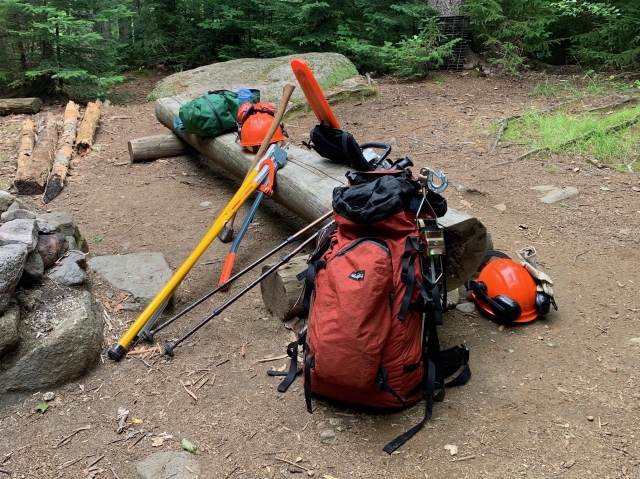
Everyone carried heavy tree-cutting equipment in and on top of backpacks. Their task was to cut down six hazardous trees which might fall, posing a risk to tent campers in the area of the shelter. Identifying the trees and cutting them down, using saws and tensioned ropes, took almost four hours of work.
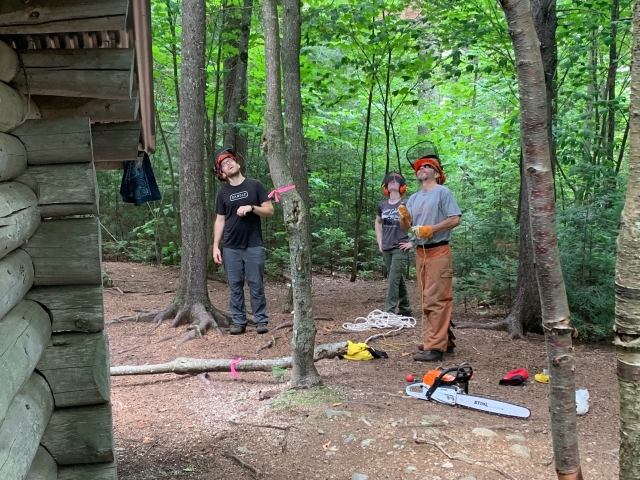
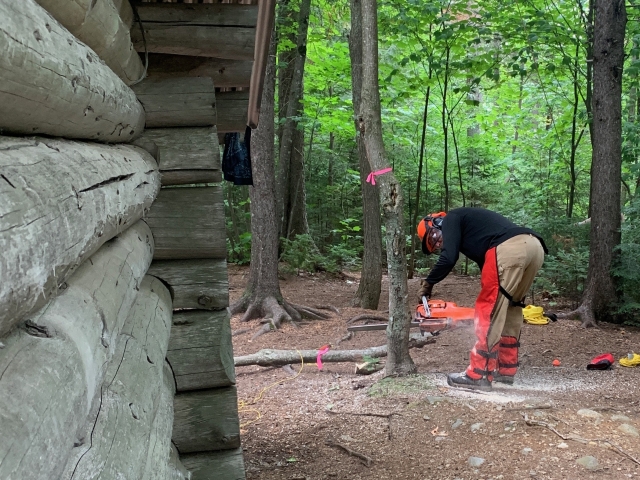
By the time the work was done, it had started to rain. The four packed up, said goodbye, and started the 1.5 mile journey back to the trailhead.
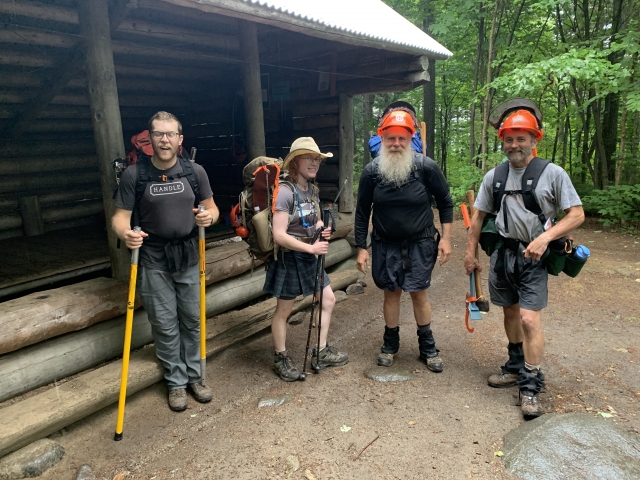
From left: Dan Hale, Paige Gregory, Tom Carr, Hawk Methany
As one thru hiker put it, “Maine is a giant stone with trees trying to grow on it.” Geology dictates the character of the Maine AT, creating streams to ford and random tangles of rocks, roots, and mud. But the hiker also encounters hundreds of bog bridges, and elegant flights of stairs made from nearby stones. As members of Allentown Hiking Club know, these and many other accommodations are the work of AT trail maintainers and builders, most of them volunteers from clubs along the trail.
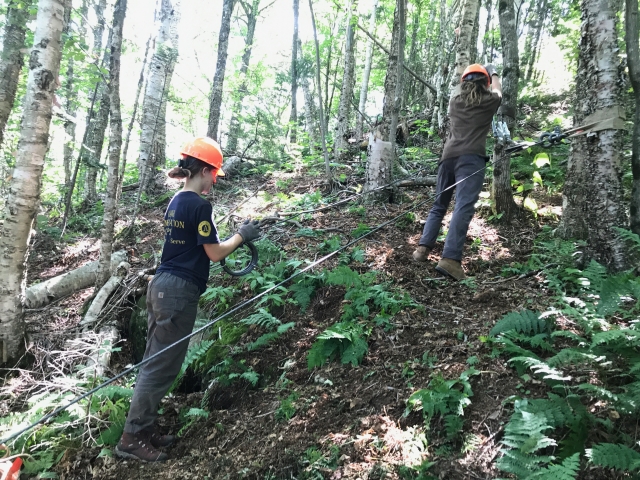
Moody Mountain, Maine. Maintainers rig a come-along and cables to position stone steps.
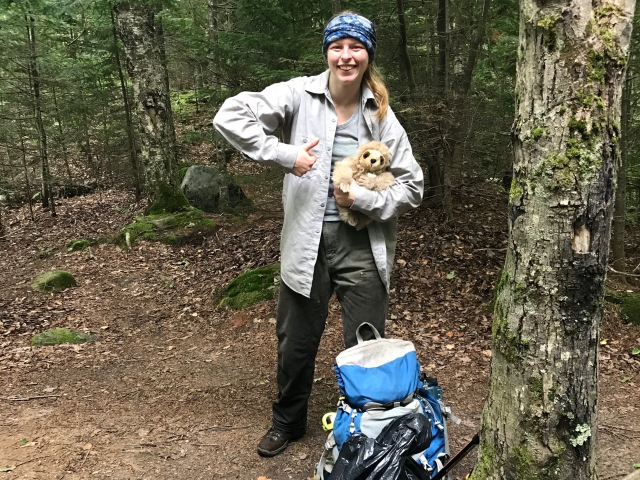
Bree is an Appalachian Mountain Club employee who tends to the campsites in New Hampshire and southern Maine.

September 8, 2019
One To Go!
By Hal Wright
One To Go!
By Hal Wright
The author, AHC's webmaster since 2002, has pursued a 21-year quest to hike the Appalachian Trail in sections.
When I walked past the Rattle River Hostel and on to the trailhead in Shelbourne, NH, I had finished 13 of the 14 Appalachian Trail states.
This summer's hikes comprised some of the most demanding and rewarding sections of the Appalachian Trail so far. The southern Maine mountains and Mahoosuc Notch lived up to their reputations as the toughest obstacles anywhere on the AT. I remain awestruck as I reflect on the rugged natural beauty of the trail environment in Maine, and will never forget seeing a bald eagle catch a fish in Kennebec River as a waited for my turn to be ferried across the river. I also had the pleasure of meeting many of the hard-working folks who keep the trail in great shape year after year for hikers like me to enjoy.
With this summer's hikes behind me, I'm about 210 miles from my goal of finishing the Appalachian Trail in sections. I thank all those who maintain the trail and help hikers along the way.
The details: Two section hikes, (1) South Arm Road near Andover ME, to Shelbourne, near Gorham NH, and (2) ME Route 27 to ME Route 201, Caratunk. Miles traveled since 1998: 1979. Miles to finish: 210.
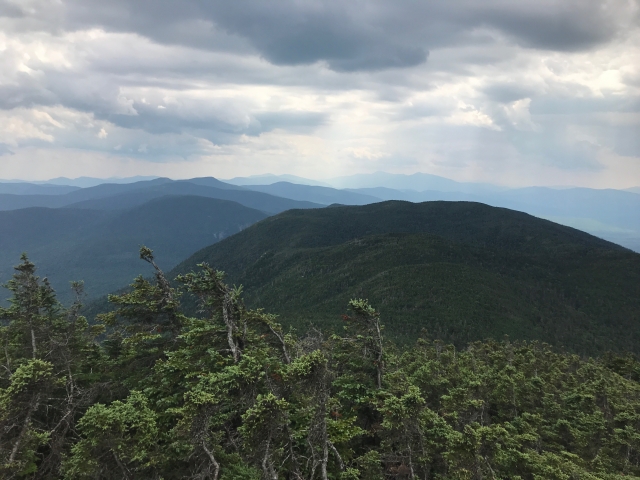
Looking Southbound into Grafton Notch State Park and toward Mount Washington.
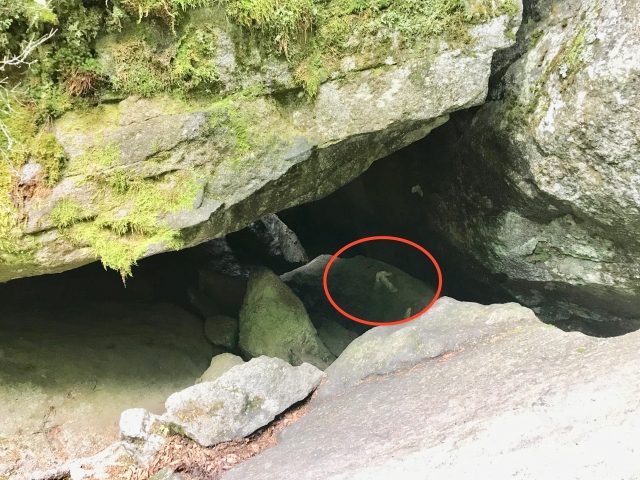
The trail in Mohoosuc Notch includes numerous passages through caverns. This one-mile section can take hours to traverse.
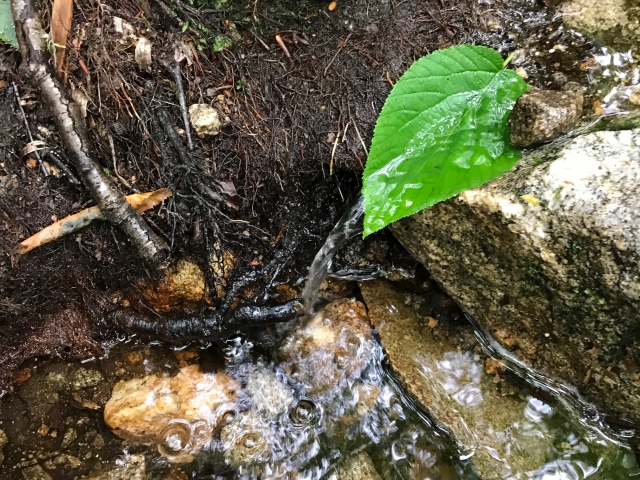
A leaf is all that's needed to quickly fill one's water bottle from a mere trickle of spring water.

A respite for the weary at Sand Beach, East Carry Pond.
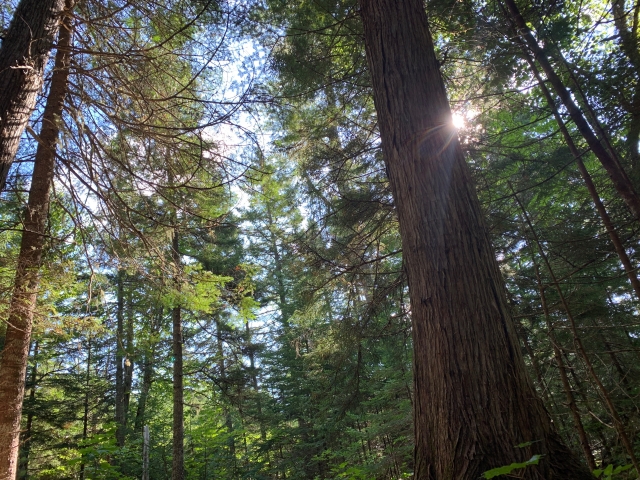
The afternoon sun peaks through a stand of Maine cedars.
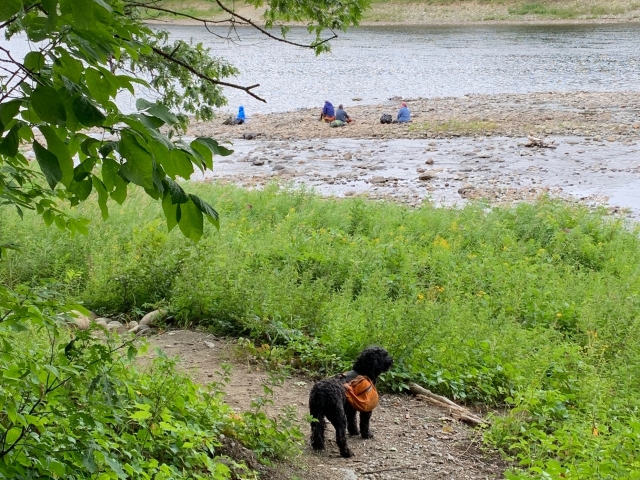
Sofia discovers the Kennebec River and hikers waiting for the first canoe ferry rides of the day.
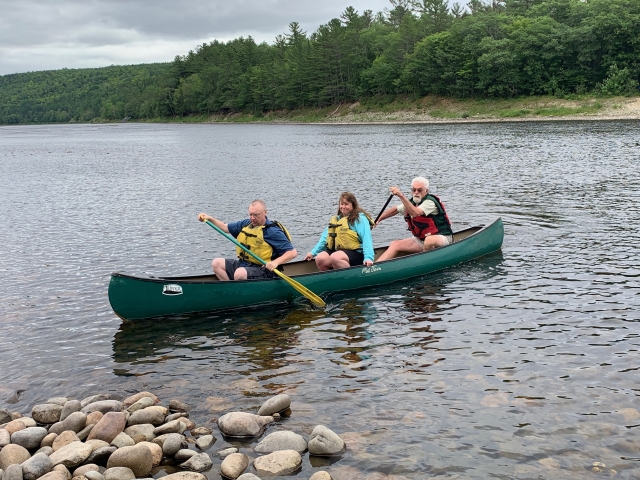
The Kennebec River ferry arrives!

July 17, 2019
Ed Ritter Named Volunteer of the Year
Ed Ritter Named Volunteer of the Year
Ed Ritter, AHC’s Trails Chair, has been selected as the 2019 Volunteer of the Year by the Mid-Atlantic Regional Partnership Committee of the Appalachian Trail Conservancy.
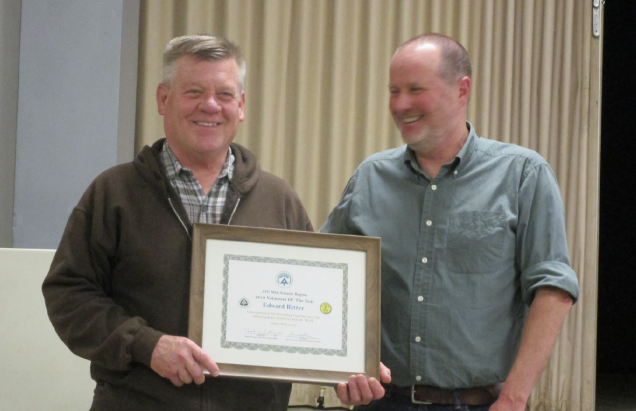
Ed’s contributions to the Appalachian Trail spanned 30 years. In 1989, Ed and Frank Bertalan were appointed AHC Trails Co-chairs. Since 1992, when Frank became the AHC Monitor Chair, Ed has served as Trails Chair.
During these 30 years, Ed has organized Appalachian Trail work trips, supervised trail relocations, scheduled shelter caretakers, and performed thousands of hours of trail maintenance. The club built a privy and constructed a new shelter during his tenure. Ed is a certified sawyer, and handles blow down removal. He has participated in AHC’s trail assessments, the trail inventory for APPA, and submits the club’s hours report to ATC each year. Ed has worked with Scouts (such as projects to earn Gold Awards) and led a special work trip for Girl Scouts in conjunction with their 100th Anniversary Celebration. Ed compiled the club’s Local Management Plans. In addition, Ed was a club corridor monitor for two areas for more than 25 years.
Edward Ritter is the consummate club volunteer. For 30 years, he has been the guiding force in maintaining and improving the Allentown Hiking Club’s Appalachian Trail section of trail, and is very deserving of this honor. Congratulations and thank you to Ed!

July 17, 2019
Help Wanted: AT Corridor Monitors
By Lucy Cantwell, Corridor Monitor Coordinator
Help Wanted: AT Corridor Monitors
By Lucy Cantwell, Corridor Monitor Coordinator
We are seeking a few new persons to help with this very important task!
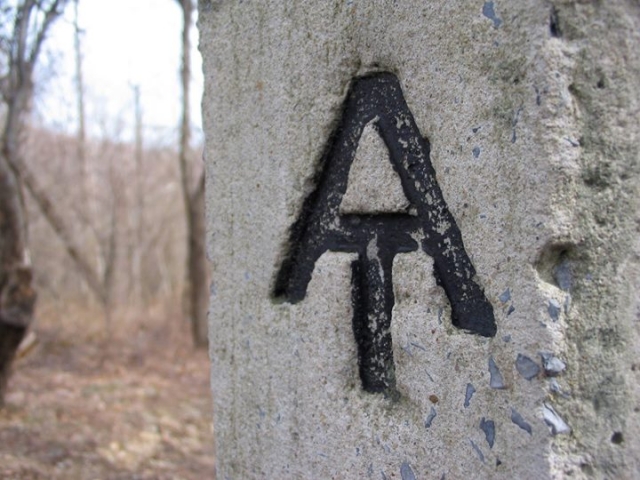
Each fall, the Allentown Hiking Club monitors the boundaries of our section of the AT, called the "corridor," which is land owned by the National Park Service that extends a few hundred feet on either side of the trail. Some of our long-time monitors, who have been performing this function for upwards of 20 years or more, are no longer able to commit to this duty.
According to the ATC Volunteer Leadership Handbook, Corridor Monitors "are responsible for visiting and reporting on the condition of an assigned area of corridor land within a Trail club’s section.... Volunteers interested in monitoring may be quite different from those who like trail work—good monitors often enjoy orienteering, bushwhacking, and traveling in rugged terrain."
The monitoring process is not unlike a scavenger hunt, with a compass and a map to assist you. If ever you are in need of an adventurous hike, this is it. If you think you might be interested in participating in the corridor monitoring, please contact the AT Monitor Coordinators listed on page 2 of the newsletter. We'll teach you how to collect the required information by pairing you with an experienced monitor assessing his/her section of the trail. The commitment on your part, after this simple training, is basically one day a year, scheduled by you at your convenience. Be adventurous! Volunteer and see what it's all about!
For an excellent description of the duties of a corridor monitor, please see this article on corridor monitoring published in the Spring 2019.

February 19, 2019
Corridor Monitoring - What It Is and Why We Do It
by Lucy Cantwell
Corridor Monitoring - What It Is and Why We Do It
by Lucy Cantwell
Walking the boundaries of Appalachian Trail lands to prevent encroachments is an essential part of our responsibilities as a maintaining club.
It's the time of year for the Allentown Hiking Club to do our annual corridor monitoring. We talk about it a each meeting, but some of you may wonder, "What is this all about?" Here is a brief explanation of this annual activity.
A critical component of our duties as a maintaining club of the AT is corridor monitoring and boundary maintenance: keeping a close eye on the federal estate purchased to protect the Appalachian Trail. The AT "corridor" is the land owned by the National Park Service that extends a few hundred feet on either side of the trail. Corridor monitoring means walking along and examining the border of this NPS land and the adjacent lands ( for example, privately owned lands, state game lands, municipalities) to assure that all boundary markers are in place and no encroachments have occurred. This involves leaving the AT treadway and bushwhacking over rocks and through dense vegetation to locate "monuments," i.e., the markers installed by surveyors years ago to establish a line between NPS lands and that of neighboring landowners.
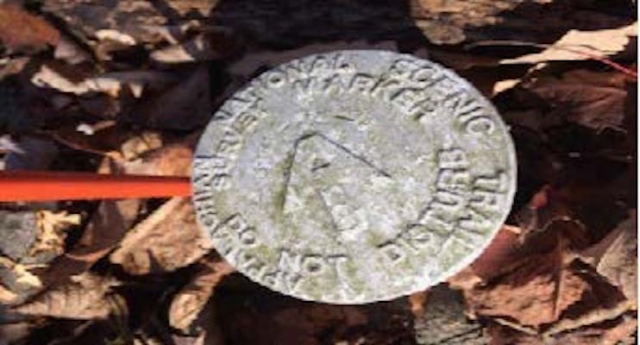
Encroachments, such as illegal dumping of waste, timber theft, rock piles, discarded machinery, hunting blinds, or evidence of incompatible uses such as ATVs are also documented. These discoveries are subsequently reported to the ATC (Appalachian Trail Conservancy) and corrective action is taken, if needed. During the monitoring we also post signage along the boundary lines, indicating which areas belong to the NPS. Volunteer monitors thus become the “eyes and ears” of state and federal landowning agencies. Monitoring helps assure the American public that its investment is being cared for and protected.
The Allentown Hiking Club monitors 35 tracts containing over 600 acres, which has 106 surveyor's monuments and 15 1/3 miles of exterior boundary. This is divided into 7 sections and is monitored by club members who commit to individual segments of about 4-7 miles each. Some of our monitors have been doing their sections for upwards of 20 years!
New volunteers are always welcome and encouraged to step up and join the action! If you think you might be interested in participating in the corridor monitoring, please contact the Monitor Coordinators listed on page 2 of the newsletter. We'd be happy to have you join one of the established monitors when they hike their section to collect the monitoring information. Also, keep an eye out for announcements on the AHC Forum, as monitors may post their hikes on the spur-of-the-moment, since good weather conditions are generally better for this activity. Be adventurous and come and see what it's all about!

POSTS BY TAG
POSTS BY MONTH